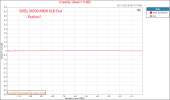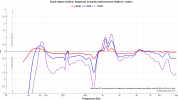Your EQ might well work for you and be an improvement for you vs the Harman Curve, but that certainly doesn't mean it's likely to work better than the Harman Curve for everyone else.....if you don't know why that is then you don't understand the Harman Research & process through which they created the target and the "science" behind it. Probability would suggest that Harman Curve is the best target that has the highest chance of sounding good for the largest percentage of people. You can't be coming out with statements that your individualised EQ "should be a big improvement for most people" (to quote you) - that's why so many people are calling you out on this, so as to put things right for the various readers of this forum. It doesn't matter if you're wrong one time, people won't hate you.Well flat out, the frequency response is not neutral, for starters.
EQ to the Harman curve is an improvement over stock, but it still sounds pretty bad. That's a good enough reason for me.
(But you can be pleased you've come up with an EQ that works very well for yourself, there's nothing wrong with that.)
Last edited:

